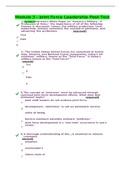Class notes
Class notes Food safety risk assessment (FHM30306) Risk assessment of food safety, ISBN: 9786200459121
- Course
- Institution
- Book
After completion of this course students are expected to be able to: - have an overview of the occurrence and characteristics of food-borne pathogens; - debate the effect of processing on the occurrence of toxic compounds and the level of pathogens present; - distinguish host responses to pathog...
[Show more]













